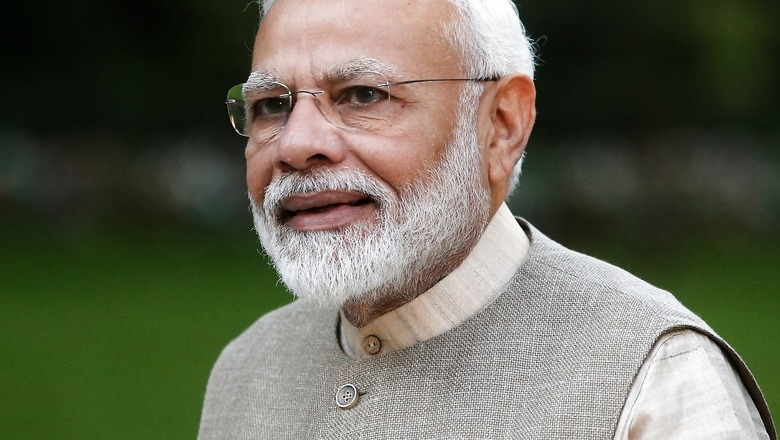
views
“One of the most important things for any leader is to never let anyone else define who you are. And you define who you are. I never think of myself as being a woman CEO of this company. I think of myself as a steward of a great institution.” – Ginni Rometty, CEO of IBM
Prime Minister Narendra Narendra Modi has clearly been the most popular and powerful leader in post-Independent India because he has always been his own person, never allowing others to define who he is, which eventually is the true hallmark of great leaders.
Socio-Political Measures: On the socio-political front, clearly, the historic step of abrogating Article 370 which came into effect in 1950 and Article 35A, which came into effect in 1954, figure high on the list of achievements. However, after Kashmir’s special status gone, vide a Presidential order and a historic decision on the floor of Parliament on August 5, 2019, people from anywhere in India can now buy property and permanently settle in the Jammu and Kashmir. With revocation of Article 370, the ball was set rolling for the return of Kashmiri Pandits who were forced to flee their homes in 1990, in one of the most horrific genocides in 1990.
Women Empowerment: From banning instant triple talaq and making it a criminal offence, defining the nation’s first menstrual hygiene protocol, amending the Medical Termination Pregnancy Act of 1971, giving women reproductive rights over their bodies and increasing the foetal gestation period from 20 to 24 weeks, welcoming more women recruits in the NCC, to banning commercial surrogacy, women empowerment has been the cornerstone of Narendra Modi’s policy making.
Foreign Policy Heft: Again, significant headway has been made on the foreign policy front. For instance, while the Quad was initiated in 2007, it was only on March 12, 2021 that the first, serious, leader-level Quad summit was held to thwart Chinese policy of expansionism and aggression that neither India nor like-minded nations have taken kindly to. One of the other big achievements of the Modi government was forcing China to undertake a syncronized and organised disengagement, starting February 2021, post the Galwan stand-off. While under an incompetent Nehru, India was forced to cede 38,000 square kilometre of Aksai Chin, under Modi, India forced China to disengage, without ceding an inch of territory. Be it the surgical strike in 2016 or the Balakot strike in 2019, or for that matter the Galwan disengagement, strongman Narendra Modi’s foreign policy has always been driven by the “India First” approach.
The Unstoppable Modi Factor: The moot question then is, what about the “Modi Factor”? The charisma and connect with the electorate, the popularity and the indomitable capacity for relentless hard work are factors that make Prime Minister Narendra Modi a leader who is in a league of his own. To even try and create a false equivalence between the indefatigable Narendra Modi and Mamata Banerjee, a fascist rabble-rouser, limited to Bengal, is doing a great disservice to even the basic understanding of Indian polity. On May 28,2021, Mamata Banerjee kept the Prime Minister and Governor of Bengal waiting and what is worse, stormed out of a review meeting to discuss the impact of the recent cyclone without bothering to make a presentation. Time and again, Mamata Banerjee has shown why she is a callous, deplorable leader, unfit for any national role in Indian politics and why TMC, the party she heads, is a certified party of goons and vandals.
A Failed Congress: Modi’s meteoric rise has led to the Congress Party’s rapid fall into oblivion, changing India’s political landscape irrevocably. The Congress has ceased to matter after a string of debilitating defeats, with compulsive liar Rahul Gandhi turning into a vacuous paper tiger on Twitter, whom no one takes seriously. The Left, barring in Kerala, has been wiped out. Mayawati and Akhilesh Yadav never had any national stature to start with and both their parties were almost reduced to nothing in the Uttar Pradesh Assembly polls in 2017, with Samajwadi Party winning only 47 seats compared to the massive 312 that the BJP won. Even in the 2019 Lok Sabha polls, while the BJP secured 62 seats from UP, the Congress was reduced to 1 seat, the Samajwadi Party to 5 seats and Mayawati’s BSP to 10 seats.
The “Khan Market Gang” has tried to resurrect the political fortunes of many failed regional satraps in a bid to checkmate the Modi aura, but these efforts repeatedly came to a naught. Winning Bihar in 2020, despite a 15-year anti-incumbency, winning Assam for the second time in a row in 2021 with a thumping majority, raising the BJP’s tally by 2467 per cent from 3 to 77 seats in Bengal, forming the government in Puducherry, winning 483 of the 576 seats in local body polls in Gujarat with 84 per cent strike rate, raising the tally in Greater Hyderabad Municipal Corporation (GHMC) polls by 400 per cent from 4 to 48 seats, winning the erstwhile impregnable bastions like Dubbaka in Telangana and Pandharpur in Maharashtra are a reflection of PM Modi’s unmatched winnability quotient.
Farm Reforms: On the economic front, the Narendra Modi government passed the historic farm laws in September 2020 to empower India’s farm community. These laws, based on recommendations of the Swaminathan Commission and the National Commission of Farmers, had been pending for 14 long years since 2006. It needs to be mentioned here that Prime Minister Narendra Modi’s agrarian reforms have been sweeping, far-reaching and inclusive. Over 6 crore farmers are availing benefit of the Pradhan Mantri Fasal Bima Yojana (PMFBY), paying a meagre premium of just between 1.5-2.5 per cent.
ALSO READ | Haryana Minister on How Direct Cash Transfer Can Boost Agri Economy, Kick-start India’s Recovery
What has the Modi government done for uplifting the well-being of India’s farm community? The Modi government has been transferring cash directly to farmers, as is evident from the Rs 6,000 per year paid to over 10 crore farmers under the PM Kisan scheme. Over Rs 1.54 lakh crore has been paid via PM-KISAN since its inception in December 2018. From just 255 million tonnes in 2012-13, under an inept Congress regime, to 297.5 million tonnes in 2019-20 and 305.43 million tonnes in 2020-21 is a vindication of how India’s self sufficiency, with exportable surplus in the foodgrain space, has added to India’s economic heft. Besides agriculture, a bright spot has been the foreign portfolio investments (FPI) amidst the pandemic, with December 2020 recording the single highest-ever monthly inflow from FPIs at Rs 62,016 crore, surpassing the previous high of Rs 60,358 crore recorded in November 2020. The year 2020 also recorded the highest ever yearly net inflow of FPIs into equities, at over Rs 1.70 lakh crore. Do note that the huge surge in FDI inflow of $82 billion in FY21 is a vote of confidence from global investors in the Modi government’s structural reforms. India’s forex reserves at over $642 billion is a new high too.
Labour Reforms: The new Labour Code seeks to transform India and rid her of outdated technologies and methodologies. The reduction in compliance burden would also facilitate expansion of establishments, helping create jobs on a large scale across a plethora of segments and sectors.
Aatmanirbhar Bharat: The Modi government announced a stimulus of Rs 2.65 lakh crore under Aatmanirbhar Bharat 3.0, taking the total stimulus since the onset of COVID-19 to Rs 29.88 lakh crore, which is almost a massive 15 per cent of the GDP. The government’s contribution to the stimulus was 9 per cent, with the remaining 6 per cent coming from the RBI. It is true that Rs 1.97 lakh crore expenditure in the form of production-linked incentives (PLIs) to 13 new sectors will be over five years. That said, there is no denying the fact that Aatmanirbhar Bharat 3.0 will have a multiplier impact on consumption, especially across stressed sectors, accelerate economic recovery and incentivise job creation through a virtuous cycle. Despite COVID second wave, most global rating agencies and the IMF are predicting a GDP growth between 9.3 per cent and 11.5 per cent for India in FY22, amongst the highest worldwide. No other leader could have or would have done what Narendra Modi did in terms of unleashing some of the most historic reforms during the pandemic to shape a new India, better equipped to deal with a post-COVID global order.
Garib Kalyan: The Rs 1.93 lakh crore allocated for the Pradhan Mantri Garib Kalyan Package (PMGKP), Rs 11.03 lakh crore allocated towards the Aatmanirbhar Bharat Abhiyaan 1.0, Rs 82,911 crore for the PMGKP Anna Yojana (which was extended till November 2020) and Rs 12.71 lakh crore infused via RBI measures, announced till 31 October 2020, not only injected liquidity into money markets, but also increased purchasing power via direct benefit transfer (DBT), improved cash flows by recalibrating EMIs and provided access to cheap credit for MSMEs, migrants and farmers.
Infrastructure: National Infrastructure Pipeline (NIP) plans to spend Rs 110 lakh crore on nearly 7,000 projects across sectors such as transport, communications, urban development, energy and water. The plan is a grand vision involving private and state-run players and many believe it is too ambitious in its scope.According to data, these projects include the Rs 3.66 lakh crore Pradhan Mantri Gram Sadak Yojana, the Rs 1.08 lakh crore Mumbai-Ahmedabad high speed rail corridor and the Rs 1.09-lakh crore North South Dedicated Freight Corridor,amongst others.
Mega COVID Vaccination Drive: Every sixth person in the world is an Indian. Also, India has a high population density of 455 persons per square kilometre. In the given circumstances, Prime Minister Narendra Modi’s decision to vaccinate everyone from 18 years onward is not only an extraordinarily bold move, but completely doable too. In an unprecedented display of political will power and conviction, the Modi government to date has administered over 77 crore (770 million) doses, with over 57.86 crore people getting the first dose.
India’s daily positivity and weekly positivity rates are at less than 3 per cent. The active caseload too is less than 2 per cent while the recovery rate is almost 98 per cent. In August 2021 alone, India administered over 18.35 crore doses, with a daily average run rate of 59.19 lakh vaccines. To date in September 2021, over 11.16 crore doses have been given, with a daily average run rate of 74.4 lakh vaccines, which is excellent by any yardstick. To put it in lay man’s terms, of late, India on an average is daily vaccinating more people than the average number of people vaccinated in 18 major nations globally.
Varanasi Model & Health Infrastructure: Clearly, Prime Minister Narendra Modi has done a phenomenal job, with the Command and Control (CAC) Varanasi model being a huge success story. While India’s electorally puny opposition has done absolutely nothing apart from blaming the PM, it is the Modi government which has done all the heavy lifting. The Congress ruled India for 60 years and could not even provide 47,000 ventilators. In just 14 months, the Modi government provided 60,000 ventilators to states. Despite ruling for 10 years between 2004-2014, the Congress under Manmohan Singh could set up only one AIIMS. In sharp contrast, in just 7 years, the Modi government has set up 15 AIIMS and the number of medical seats too has gone up by 70 per cent, from 52,000 in 2014 to 88,250 now. Hence, the Congress and its paid brigade of jaded acolytes, journalists and “Durbaaris” have no political or moral authority whatsoever to wax eloquent about India’s health infrastructure. While the Nehru-Gandhi parivaar and their family retainers left India’s healthcare in a shambolic state, it is PM Modi who has been steadfastly putting the system back on track, with almost Rs 3 lakh crore dedicated to health spending in 2021-22 alone.
OPINION | With 1 Crore Jabs in a Day, Indian State Has Given Befitting Reply to Detractors
Make in India: Speaking of vaccines, Bharat Biotech’s homegrown Covaxin, made along with ICMR, is a tribute to India’s stellar Make in India initiative. The telecom reforms and setting up of a Bad Bank, decisions announced in the last 48 hours, will further propel India’s corporate sector and unleash the animal spirit by eradicating the NPA mess left behind by successive Congress regimes, much before the Modi government assumed charge in 2014.
Speaking of the virus, while Rahul Gandhi did nothing for the people of his constituency in Wayanad besides trolling the Modi government on Twitter and Sonia Gandhi did zilch for the people of Rae Bareli, it is Prime Minister Narendra Modi who has been toiling hard 24/7 to ensure India’s war against Covid is taken to its logical conclusion. While the Modi model has been powering ahead, the Kerala model has failed miserably, with over 73 per cent of India’s daily new COVID cases coming from Kerala alone.
The good news for Indians and India lovers is that Prime Minister Narendra Modi ran the world’s biggest food security programme amidst a full fledged lockdown in 2020, wherein every month, for 9 months in a row, 810 million people, including daily wage earners and migrant workers, were given free foodgrain. Basically, every month, for 9 months at a stretch, India fed a population that was almost 2.5 times the size of the US in 2020. The scheme is underway in 2021 too.
In 2021, in yet another ambitious turn of events, India is in the midst of the largest and most ambitious vaccination drive mankind has seen. Given his past track record of seamlessly translating vision into reality, PM Modi is set to deliver, yet again! Don’t forget India is a massive country with a population that is equal to the population of 196 countries. Solely due to the indefatigable conviction of Prime Minister Narendra Modi despite being a country that is widely spread out geographically, India has in the shortest time span vaccinated over 61 per cent of its adult population with at least one dose, despite the opposition promoting “vaccine hesitancy”. Also, overall, more than 54 crore COVID tests have already been conducted, keeping in sync with the larger goal of testing, tracking and treatment.
In the movie ‘The Curious Case of Benjamin Button’, there is a dialogue which goes: “Our lives are defined by opportunities, even the ones that we miss.” Well, the last two years of the Modi government have been extraordinary for the sheer number of opportunities that were seized to create new milestones. “When the world is in crisis, we must pledge—a pledge which is bigger than the crisis itself. We must strive to make the 21st century India’s century. And the path to do that is self-reliance”—this powerful quote by Prime Minister Narendra Modi sums up the ethos of his vibrant political philosophy in more ways than one.
The writer is an Economist, National Spokesperson of the BJP and the Bestselling Author of ‘Truth & Dare: The Modi Dynamic’. The views expressed in this article are those of the author and do not represent the stand of this publication.
Read all the Latest News , Breaking News and Ukraine-Russia War Live Updates here.




















Comments
0 comment